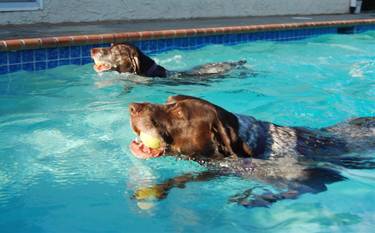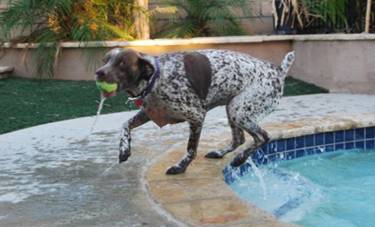
Suffocation by drowning is caused by the lungs filling with water or other fluid. Some pets can seemingly recover from a near-drowning incident, only to succumb to a collection of fluid in the lungs (known as pulmonary edema) hours later. This phenomenon is known as ‘dry drowning’ and can be fatal. For this reason, all pets that have fallen into a pool or other body of water should be evaluated by a veterinarian and observed for complications.
Dog swimming

Photo by Lori Charpentier
What to Do
- Remove your pet from the water if it can be done safely.
- Place him on his side with his head and neck extended. It's preferable to have the head slightly lower than the body to promote drainage of water from the lungs and to avoid inhalation of stomach contents (aspiration).
- To expel water from the lungs and stomach, pull the tongue forward and gently push on the chest wall and stomach. Take care to avoid being bitten.
- Begin CPR as required.
- Cover the pet with a blanket to avoid further heat loss.
- Seek veterinary help as soon as possible.
- Secure the water source to prevent other pets and children from gaining access and falling in.
What NOT to Do
- Do not fail to seek veterinary help just because your resuscitation is successful and your pet seems to be recovering. Numerous secondary complications (i.e., electrolyte imbalance, hypothermia, pneumonia, fluid in the lungs) can occur.
- Do not leave the pet unattended as they may be confused and wander back to the water.
Dog by Pool

Photo by Lori Charpentier
Almost all cats and dogs instinctively know how to swim. Unfortunately, they also instinctively swim to the nearest edge of a pool to get out. Usually that is not the right decision. Most animals are unable to get out of a swimming pool at the edge and must swim to a step. If they don’t know where the steps are and fall in, they will try to swim to the nearest edge and attempt to get out, or may tire out and drown. If your pet has access to a swimming pool, you must teach them where the steps are.
Browse the complete Veterinary Partner First Aid collection.